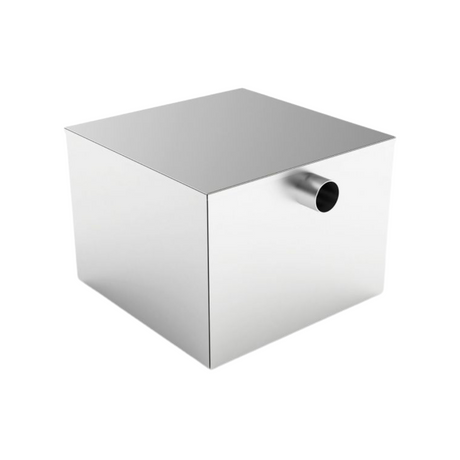Besoin d’un accompagnement ou d’un devis personnalisé ?
ARKA
Stainless steel grease trap 385x385x290mm
• 385x385x290mm
From 1351€HT /moisUnit price /Unavailable
Grease trap for professional restaurant
Restaurant grease traps are essential equipment for effective food waste management. Discover our range of grease traps, designed to meet the needs of restaurants, commercial kitchens and catering establishments.
Effective fat management
Our grease traps are designed to collect and retain grease and oils from commercial kitchens, preventing drain blockages and environmental issues. Their robust, leak-proof design ensures reliable performance and reduced maintenance costs.
Ease of installation and maintenance
We offer professional installation of our grease traps, tailored to your kitchen layout and current regulatory standards. In addition, our traps are designed for easy maintenance, with accessible components and simple cleaning processes, ensuring continued use without interruption.
Regulatory and environmental compliance
Our grease traps meet the highest health and environmental standards, ensuring your facility's regulatory compliance and environmental protection. They are designed to effectively capture grease and solids, reducing wastewater pollution.
Tailor-made options to meet your needs
We offer a variety of grease trap options to meet your specific needs, including different sizes, construction materials, and advanced filtration systems. Our team is here to help you choose the best solution for your kitchen.
Reliability and durability for intensive use
Made with high quality materials and a robust design, our grease traps are designed to withstand heavy use in commercial environments. Their reliability ensures years of trouble-free service, reducing downtime and maintenance costs.
FAQ about professional grease traps
What is the ideal capacity of a grease trap for a restaurant?
The ideal capacity of a grease trap for a restaurant depends on the daily volume of fats and oils used in the kitchen, as well as the frequency of emptying required. It is recommended to choose a grease trap with sufficient capacity to effectively handle the food waste generated.
How to install a grease trap in a restaurant?
Grease trap installation in a restaurant should be done by qualified professionals in accordance with local and national plumbing and sanitation regulations. It is important to locate the grease trap in an accessible location for emptying and to properly connect it to the wastewater system.
How to maintain a grease trap in a restaurant?
Regular maintenance of a grease trap in a restaurant includes periodically emptying accumulated grease and solids, cleaning filters and internal components, and checking the system for leaks and proper operation. Regular maintenance helps ensure optimal performance and extend the life of the grease trap.
What are the benefits of using a grease trap in a restaurant?
The benefits of using a grease trap in a restaurant include reduced drain clogs, regulatory compliance, environmental protection, reduced maintenance costs, and improved kitchen operational efficiency.
How much does it cost to install a grease trap in a restaurant?
The cost of installing a grease trap in a restaurant can vary depending on factors such as the size of the trap, the complexity of the installation, local regulatory requirements, and labor costs. It is recommended to request quotes from multiple vendors to get an accurate cost estimate.
What materials are used to make a restaurant grease trap?
Restaurant grease traps are typically made of stainless steel, fiberglass-reinforced plastic (FRP), or high-density polyethylene (HDPE). These materials are chosen for their corrosion resistance, durability, and ease of cleaning.
What are the regulations regarding the use of grease traps in restaurants?
Regulations regarding the use of grease traps in restaurants vary by local and national jurisdictions. In general, restaurants must comply with environmental and health standards for food waste and wastewater management. It is essential to consult with the relevant authorities for specific requirements in your area.
What are the consequences of not using a grease trap in a restaurant?
Failure to use a grease trap in a restaurant can result in clogged drains, odors, regulatory violations, and environmental damage. Grease and oils washed down the drain can cause pollution and water contamination problems.
How to Choose the Right Size Grease Trap for a Restaurant?
When choosing the right size grease trap for a restaurant, it is important to assess the volume of grease and oils generated by kitchen activity, as well as the frequency of emptying required. Grease trap suppliers can help you determine the required capacity based on your specific needs.
What features should you look for when purchasing a grease trap for a restaurant?
When purchasing a grease trap for a restaurant, look for features such as grease holding capacity, ease of cleaning, corrosion resistance, regulatory compliance, and manufacturer warranty. Choose a grease trap that meets your operational and environmental needs.
How to prevent bad odors from a grease trap in a restaurant?
To prevent unpleasant odors from a grease trap in a restaurant, be sure to clean the trap regularly, drain accumulated grease, use effective cleaning products, and control leaks or spills. Regular maintenance and proper waste management can help reduce unwanted odors.
How often should a grease trap be emptied in a restaurant?
The recommended frequency for emptying a grease trap in a restaurant depends on the volume of grease generated, the capacity of the trap, and local regulations. In general, grease traps should be emptied regularly to prevent drain blockages and environmental problems. It is recommended to follow the manufacturer's recommendations and consult with local authorities to determine the appropriate emptying frequency.
How do you know if a grease trap is full in a restaurant?
To determine if a grease trap is full in a restaurant, monitor grease and oil levels through viewing windows or level indicators, and regularly check for buildup of debris and signs of blockages in the drains. Regular monitoring helps identify the need for grease trap emptying and maintenance.
